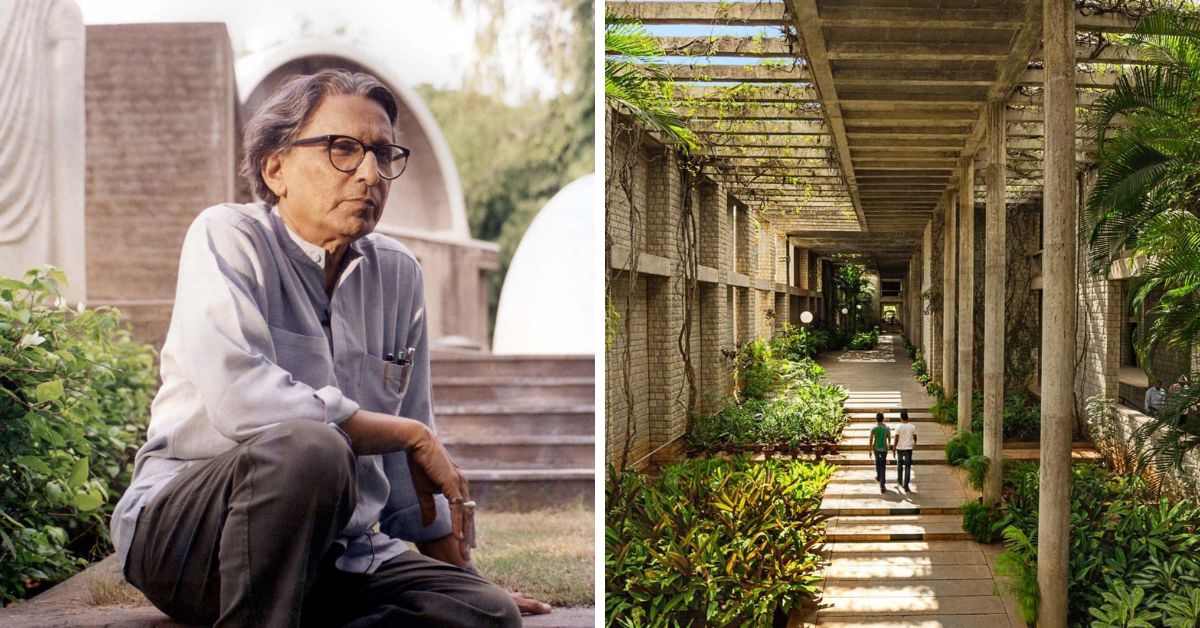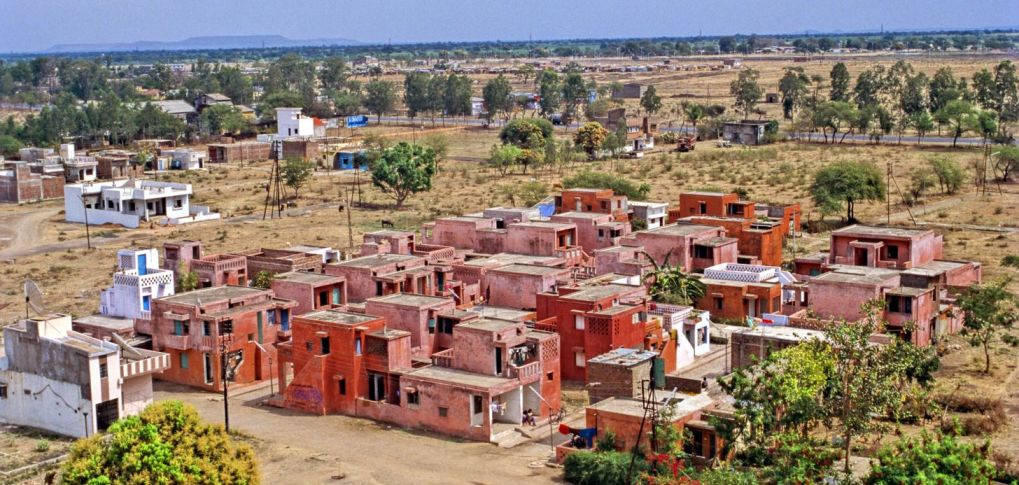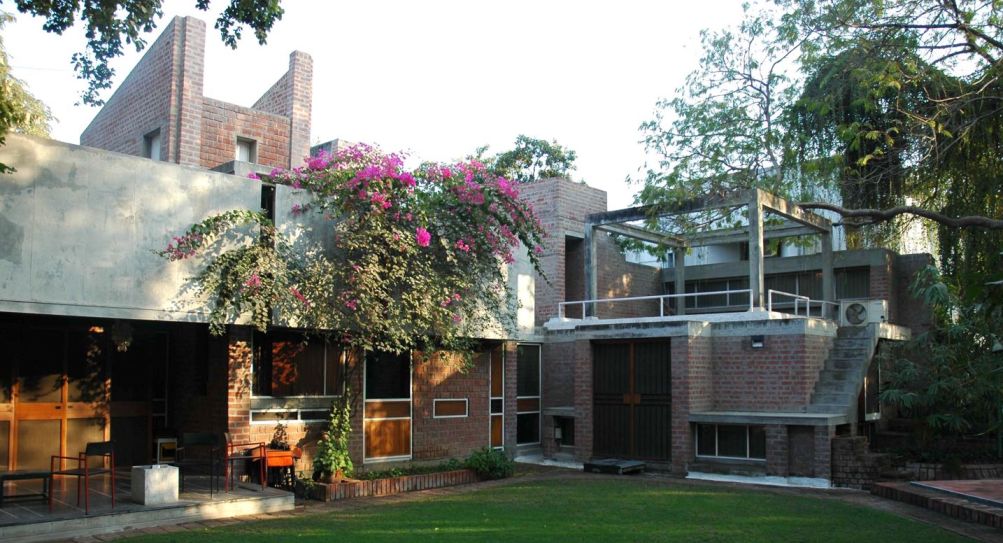One of India’s Greatest Architects, 94-YO Built 6500 Sustainable Homes for the Poor
Balkrishna Vithaldas Doshi—the first Indian to win the Pritzker Prize—talks about how to find symphony and sustainability in architecture.

“Every building shows distinct facets at different times of the day. For example, the soft morning sunlight will give it a separate, distinct look from the harsh afternoon sunlight. The setting sunlight will give it another unique appearance. Soft rain will make the same building look different from when it’s completely drenched in torrential downpours. So, when we want to make a dwelling for someone, we have to think of all these aspects,” explains Balkrishna Vithaldas Doshi, the doyen of the world of Indian architecture.
Listening to him over the phone was like listening to an artist talk about a painting or a work of art. Chuckling softly and agreeing with this observation, the 94-years-old architect says, “Architecture is a work of art and the architect is an artist. It’s not just putting up brick and mortar together. It’s like a painting that is worked with the consideration of the emotions of the people who would be residing in it. It’s the resident’s sampatti (assets, wealth). We have to take care of it.”
The Ahmedabad-based Doshi is a nonagenarian and winner of awards like the Padma Shri, Padma Bhushan, Pritzker Architecture Prize (recognised as the ‘Nobel Prize’ in architecture), and many others, including the latest Royal Gold Medal, awarded this year by the Royal Institute of British Architects on behalf of the British Monarch — the highest architectural award of the UK Government.
He has been practising architecture for 60-plus years and comes from a family of seven architects, including his daughter, son-in-law and grandchildren.

Living in one of the most crowded and congested places in Mumbai — near the Crawford market area, Doshi remembers, “We would sit on our balcony in the multistorey building with our morning cup of chai and newspaper and talk to our neighbours from our building and also the opposite building sitting on their balconies. That makes it a home—even a small flat with a nuclear family but where people interact will be an inclusive home with good vibes where there is much laughter and conversation!”
It was a similar idea of having an ‘open house’ where there would be a lot of interaction among family members and neighbours that prompted him to plan the acclaimed — Aranya, a low-cost housing project in Indore, Madhya Pradesh.
Built for economically weaker sections (EVS), each house was planned with the possibility of finding new alternatives for a growing family in the allotted space for comfortable living. Nearly four decades later, this township comprising 6,500 dwellings is an image of harmony, freedom and social togetherness. This project won the Aga Khan Architecture Award in 1995 and was mentioned in the UK government’s latest award.

Doshi believes in a sustainable and economical approach while planning a project and, most of the time, uses only locally sourced materials. Maximum usage of natural light is planned, and the cavity walls help trap and minimise heat.
This is also how his home, Kamala house in Ahmedabad, is built.
Explaining the construction of the family home, his architect daughter Radhika Doshi Kathpalia says, “Cross grid of the square plan is supported by four square columns and load bearing brick walls and brick cavity walls on the periphery. This helped papa extend the house whenever there was a need. Numerous parts of our house are spread on multiple levels. The opening of major spaces towards the rear garden transforms the house into a pavilion in a garden setting, which makes it convenient to sit and talk.”
She further explains that she grew up in a house with open spaces that didn’t create any restrictions. “Our house was full of music, art, laughter. Many artists would come to spend days with papa. So, the open spaces in the house’s structure helped all of us. Until today, music is always playing in the house, and artists spend time talking about art and their work. During one of such meetings, papa and the late artist M F Husain decided to create the now famous Amdavad ni Gufa,” says Radhika.

Amdavad ni Gufa is an underground egg-shaped art gallery in Ahmedabad and is considered a marvel in the world of architecture. The design comprises circles and ellipses. Illumination is through snouts created on the outside walls, so sunlight comes in, forming spots of light which move around as the day progresses.
Doshi’s one condition to his artist friend was he would make a unique art gallery the only one of its kind not only in the country but in the entire world, provided Husain uses the walls and the ceiling as his canvas instead of hanging canvases. So, Husain painted motifs of animals, including his signature horses, human figures on the walls and a 100 ft long Sheshnag (divine serpent) on the ceiling!

There are more than 100 such famous buildings designed by Doshi and spread all over India like the buildings of educational institutes IIM Bengaluru, Institute of Indology Ahmedabad, CEPT Ahmedabad, NIFT Delhi, Sawai Gandharva theatre Pune, and their own office Sangath to name a few. Each building is unique and outstanding. As Radhika says, “My father loves to experiment with new ideas each time he gets a project. He doesn’t restrict himself to a particular style’’.
Summing up what makes a good architect, Doshi, in a short film by Ashutosh Shah and Taher SM displayed on his official website ‘Sangath’, said, “Create a bond, a sense of belonging, not just with the physical form but with eyes, sound and with senses, and then a landscape will begin to appear. The question I ask is what was important — the form of the building or the content? The space. Look around every object around us, nature itself, the lights, sky, water, and the stone. Everything is in symphony. And this symphony is what architecture is all about.”
Edited by Yoshita Rao
If you found our stories insightful, informative, or even just enjoyable, we invite you to consider making a voluntary payment to support the work we do at The Better India. Your contribution helps us continue producing quality content that educates, inspires, and drives positive change.
Choose one of the payment options below for your contribution-
By paying for the stories you value, you directly contribute to sustaining our efforts focused on making a difference in the world. Together, let’s ensure that impactful stories continue to be told and shared, enriching lives and communities alike.
Thank you for your support. Here are some frequently asked questions you might find helpful to know why you are contributing?


This story made me
-
97
-
121
-
89
-
167













